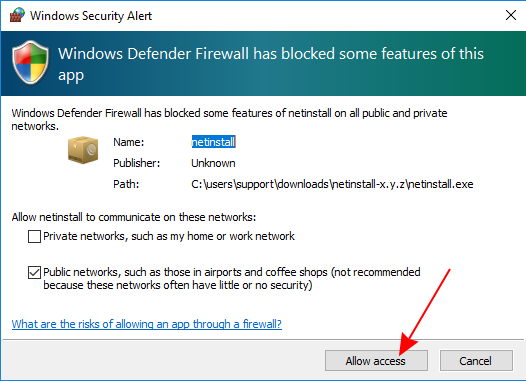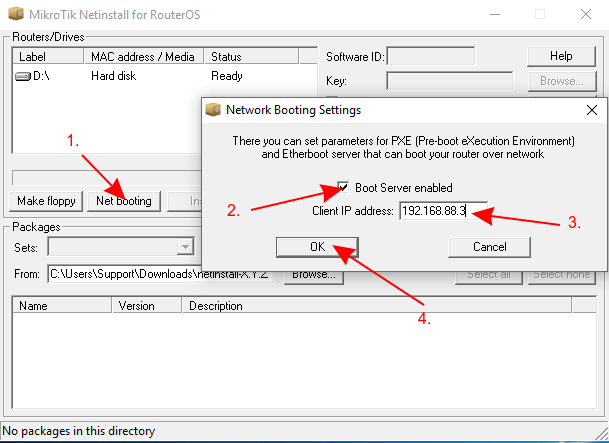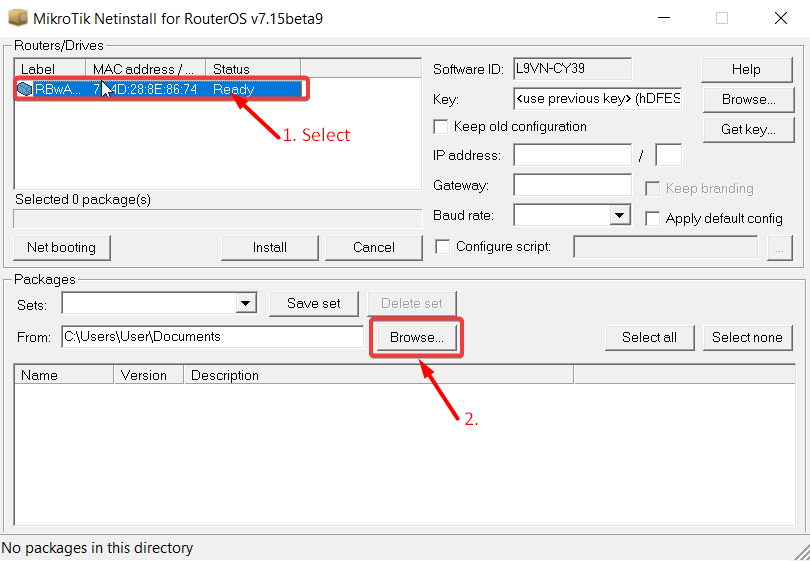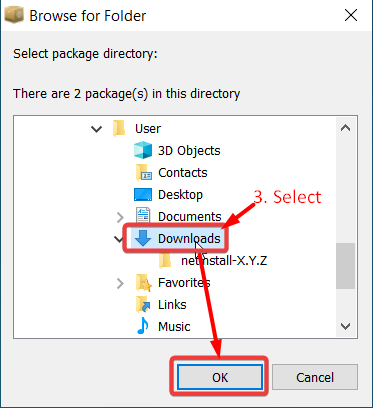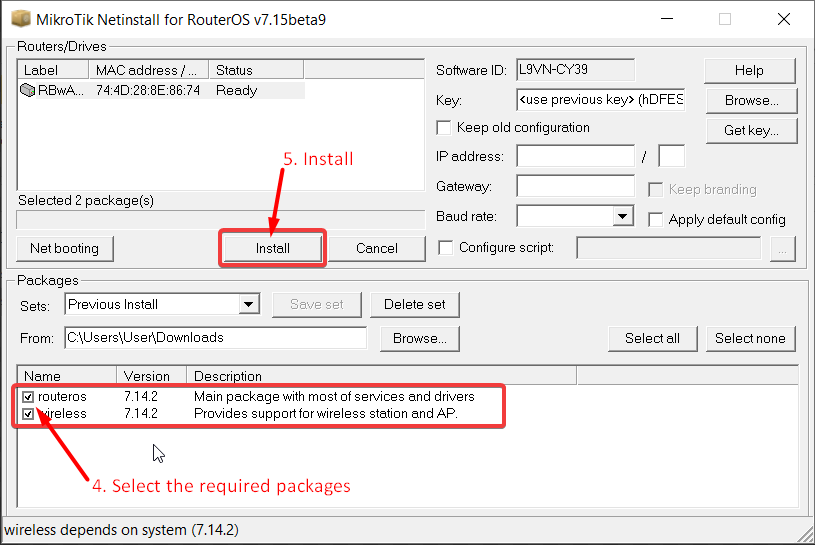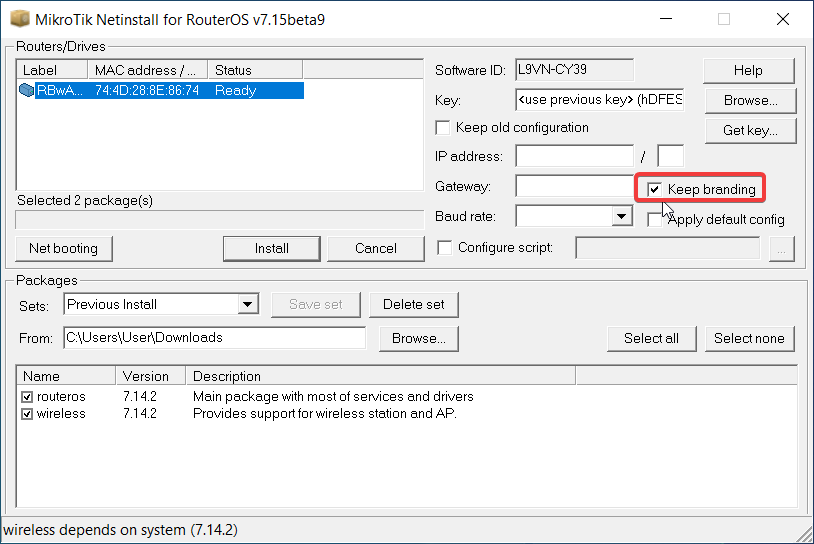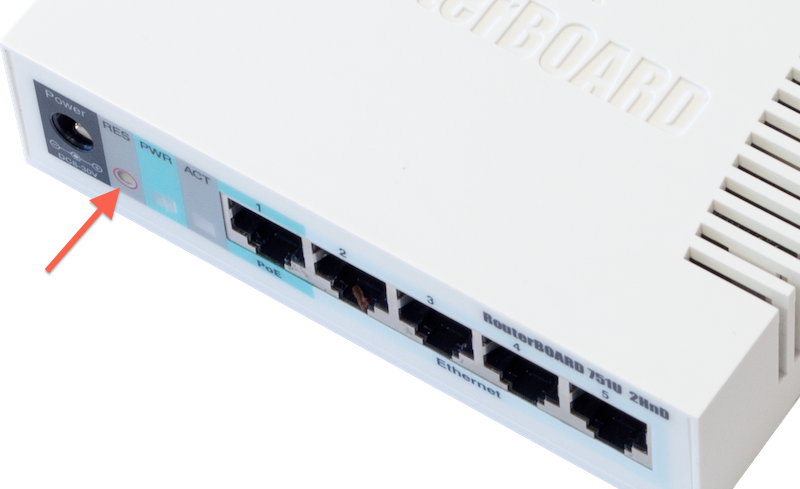...
- Download Netinstall from the downloads page. If you are not sure which version you need, then you can always select the version that is marked as Current (stable);
Download the RouterOS Main package from the downloads page;
Tip You must choose a RouterOS version. You can always select the version that is marked as Current. You must also select the architecture (ARM, MIPS, SMIPS, TILE, etc...), but if you are not sure, then you can download the RouterOS package for ALL architectures, Netinstall will choose the right architecture for you.
Disable all of your computer network interfaces (WiFi, Ethernet, LTE, or any other type of connection) besides the one that which will be used for installation! Netinstall will only work on one active interface on your computer, it is highly recommended that you disable any other network interfaces in order to be sure that Netinstall will select the right network interface.
Configure a static IP address for your Ethernet interface, open Start, and select Settings:
...
| Tip |
|---|
Netinstall can run also on a local network, in such case , you could skip setting a static IP address, but it is highly recommended that you set a static IP address if you are not familiar with Netinstall. |
...
Make sure that the Ethernet interface is running and launch Netinstall.exe. If you followed the guide precisely, then you should not have any Internet connection on your computer, Windows 10 wants to verify all apps that it runs, but will not be able to do it due to since lack of an Internet connection, for this reason, a warning might pop up, you should click Run.
...
| Warning |
|---|
Netinstall requires administrator rights, there should be a window asking for permissions to run Netinstall, you must accept these permissions in order for Netinstall to work properly. |
- Allow access for Netinstall in Public networks and configure Net booting settings and fill out the required fields as shown in the image below
| Warning |
|---|
| The " Client IP address " must be unique! Don't use an existing IP address in your network, this also means that you should not use the computer's IP address as well. Use a completely different IP address from the same subnet. |
- Connect your device to your computer using an ethernet cable directly directly (without any other devices in-between), and plug the Ethernet cable into your device's Etherboot port.
- MikroTik devices can are able to use Netinstall from their first port (Ether1), or from the port marked with "BOOT".
...
| Warning |
|---|
Some computers have a network interface (especially USB Ethernet adapters) that tend to create an extra link flap, which is enough for Netinstall to fail to detect a device that is in Etherboot mode. In such a case you can use a switch between your device and your computer or a router in bridge mode to prevent this issue. Netinstall uses bootp packets, which use are using the same port numbers as DHCP packets. If you're using a switch between your PC and the device to be Netinstalled, ensure that the ports in the bridge are not blocked by other network devices. If you have dhcp-snooping enabled, make sure to enable "trusted" on the bridge ports facing the Netinstall PC. |
- Power up your device and put it into E etherboot mode
| Tip |
|---|
There are multiple ways how to put your device into Etherboot mode. Make sure you read the Etherboot manual before trying to put the device into this mode. Methods vary between different MikroTik devices. |
- Wait for the device to show up in Netinstall, then select it , and pressclick Browse. Navigate to your Downloads folder (or wherever you saved your RouterOS packages) and press OK.
...
- Select your desired RouterOS version packages and press Install. Wait for the installation to finish and press "Reboot" (Devices without serial console have to be rebooted manually).
| Note |
|---|
If you have downloaded RouterOS packages for multiple architectures, then Netinstall will only show display the appropriate architecture packages for your device after you have selected it. All unsupported Unsupported packages will not show up appear in this window after you have selected once a device is selected. |
...
If the installation does not start (the progress bar is not moving or no status is shown), then you can try closing the Netinstall application and opening it up again or try to put the device into Etherboot mode again. If you are still unable to get Netinstall working, then you should try using it on a different computer since there might be an operating system's issue that is preventing Netinstall from working properly.
...
| Warning |
|---|
After using Netinstall the device will be reset to defaults (unless you specified not to apply default configuration). Some devices are not accessible through ether1 port with the default configuration for security reasons. Read more about Default configuration. |
| Note |
|---|
Option "Keep brandingbrainding" allows you allow to keep the on device's already installed branding package without reinstalling it using Netinstall. |
| Note |
|---|
The "Keep old configuration" process involves downloading the configuration database from the router, reinstalling the router (including disk formatting), and uploading the configuration files back to it. However, it's important to note that this process solely applies to the configuration itself and does not impact the files, including databases like the User Manager database, Dude database, and others. |
...
| Tip |
|---|
When using the Configure script option, it is suggested to introduce a delay before configuration execution. Configure script pre-configures the device with the provided configuration (text file in .RSC format). This configuration also takes the place of the default configuration. The script can access factory passwords with read-only variables $defconfPassword and $defconfWifiPassword |
Instructions for Linux
The Linux version is a command line tool, which offers nearly the same parameters as the Windows counterpart.
...
| Parameter | Meaning |
|---|---|
| -r | When the reinstallation process is performed, the configuration is reset, and for devices that have it, the default configuration will be applied. (optional) |
| -e | When the reinstallation process is performed reset the device to empty configuration. |
| -b | Option to discard the currently installed branding package from the device, otherwise it will be reinstalled together with RouterOS |
| -k keyfile | Provides the device with a license key in .KEY format. (optional) |
| -s userscript | Pre-configures the device with the provided configuration (text file in .RSC format). This configuration also takes the place of the default configuration. The script can access factory passwords with read-only variables $defconfPassword and $defconfWifiPassword (starting from RouterOS 7.10beta8). (optional) |
-a IP | Uses a specific IP address that the Netinstall server will assign to the device. Mandatory, but can be auto-assigned if interface parameter is used. |
| PACKAGE | Specify a list of RouterOS.NPK format packages that Netinstall will try to install on the device. (mandatory) |
| -i | Allows you to specify an interface. (optional) |
...
| Note | ||
|---|---|---|
| ||
If the "-r" or "e-" parameter is not specified, netinstall-cli will reinstall RouterOS RouterOS and will keep the current configuration by downloading the current configuration database from the router, reinstalling the router (including disk formatting), and uploading the configuration back to it, the same as Netinstall "Keep old configuration" option. However, it's important to note that this process solely applies to the configuration itself and does not impact the files, including databases like the User Manager database, Dude database, and others. |
First , make sure you have set the IP on your computer's interface:
...
The Reset can be found on all MikroTik devices, this button can be used to put the device into Etherboot mode. An easy way to put a device into Etherboot mode using the Reset button is by powering off the device, holding hold the Reset button, powering power on the device while holding the Reset button , and keep holding it until the device shows up in your NetinstallNetinstalll window.
| Warning |
|---|
If you have set up a Protected bootloader, then the reset button's behavior is changed. Make sure you remember the settings you used to set up the Protected bootloader, otherwise , you will not be able to use Eterboot mode and will not be able to reset your device. |
RouterOS
If your device can is able to boot up and you can are able to log in, then you can easily put the device into Etherboot mode. To do so, just connect to your device and execute the following command:
...
After that either reboot the device or do a power cycle on the device. Next time the device will boot up, then it will first try going into Etherboot mode. Note that after the first boot - up, the device will not try to go going into Etherboot mode and will boot directly from NAND or from the storage type the device is using.
...
Some devices come with a serial console that can be used to put the device into Etherboot mode. To do so, make sure you configure your computer's serial console. The required parameters for all MikroTik devices (except for RouterBOARD 230 series) are as followsfollowing:
| Code Block | ||
|---|---|---|
| ||
115200bit/s, 8 data bits, 1 stop bit, no parity, flow control=none by default. |
For RouterBOARD 230 series devices the parameters are as followsfollowing:
| Code Block | ||
|---|---|---|
| ||
9600bit/s, 8 data bits, 1 stop bit, no parity, hardware (RTS/CTS) flow control by default. |
...
